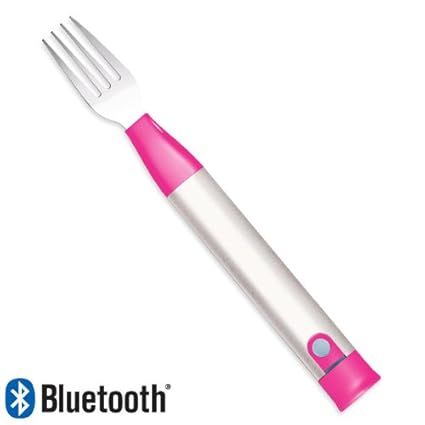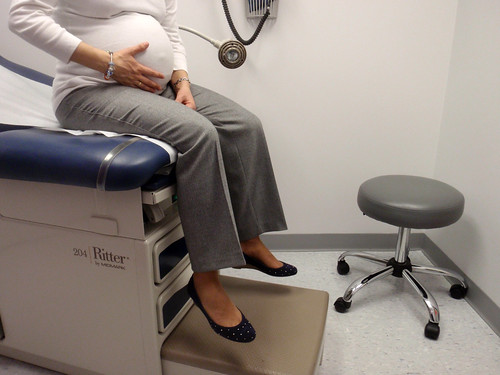Get HAPI ... Fork
For
the holidays this year, I received many lovely gifts and some of them
have even caused me to change around my weekly challenges for my
countdown to TTC. One such gift was the HAPI fork
(pictured above). I had been thinking about various habits I could try
to adopt that encourage mindful eating (such as putting down my fork
between bites, counting how many times I chew, serving my food on a
smaller plate and waiting a certain amount of time before going back for
seconds, etc.), but this new gadget really gave me a way to get started
on those mindful eating goals without quite so much "mindfulness".
The HAPI fork is a mindful eating tool that subtly warns you when you are eating faster than you should be. The fork has an internal brain that measures each bite you take and then records how long you wait until the next bite. If your next bite is sooner than a preset interval (default is 10 seconds), then the fork vibrates and a little light briefly turns red. If you are eating at the preferred interval, you can see the light turn green with every bite but otherwise it just acts like a normal fork.
Of course, I do think it is good to move toward actual mindful eating and a deep awareness of what is going on between myself and my meal, but for someone who has a hard time slowing down while eating and a tendency to shovel food this HAPI fork is a great help. Even when I start a meal with focus, I tend to become kindof zombie-like about midway through and just hork down the second half of my portion without really thinking or sometimes even tasting it. Part of that is related to other bad habits, but some of it is that I start to pick up speed as the meal goes on and I'm no longer quite as hungry.
Although I find it inconvenient to use this fork at every meal (that's a fair bit of re-washing throughout the day), I find that I can use it once a day or so pretty easily. Conveniently, the non-electronic part of the fork is dishwasher safe so I can give it a thorough clean once in a while. Just have to make sure to remove the electronic "brain" before immersing it in water!
You are supposed to turn the fork on at the start of a meal and turn it back off at the end. Any time there's at least a 15 minute interval after eating, the fork decides you have finished eating and records all the bites taken before that time as a meal. Using the HAPI website, you can track your eating stats and monitor your progress toward goals by plugging the fork's "brain" in and letting it download your data. I don't have a smart phone, but I also think the fork is wireless Bluetooth enabled and can transmit your data directly to a smart phone or tablet, which would probably be more convenient.
Below is a picture of the output the site gave me after my first HAPI fork meal (which happened to be Christmas dinner):
You find out how much of the time you were eating faster than target, how long on average you waited between bites, how long you spent on the meal, and how many total bites you took during the meal. Although these data might not be particularly important for any one meal (except perhaps to discover how long you spent eating a specific meal), over time they do allow you to monitor your success and progress. Plus, if you have a scientific way of thinking, like myself, it's just a pleasure to see so much quantitative evidence about yourself presented in such an appealing manner.
As I approach my TTC start date, I will continue to use the HAPI fork but also try to move toward a more internalized mindful eating habit. Still, when I know I'm really cognitively depleted and just can't pay any attention to how long I'm taking between bites, it's nice to know I can have a good angel reminding me to slow down and care about what I'm putting into my body.
What about you? Any great strategies or gadgets that help you eat mindfully or live a healthy lifestyle? What do you think about the HAPI fork -- brilliant or evil? What eating habits of yours would you most like to be more conscious about or improve on?
For more in this countdown series, see last week's challenge about Counting pregnancy costs.
The HAPI fork is a mindful eating tool that subtly warns you when you are eating faster than you should be. The fork has an internal brain that measures each bite you take and then records how long you wait until the next bite. If your next bite is sooner than a preset interval (default is 10 seconds), then the fork vibrates and a little light briefly turns red. If you are eating at the preferred interval, you can see the light turn green with every bite but otherwise it just acts like a normal fork.
Of course, I do think it is good to move toward actual mindful eating and a deep awareness of what is going on between myself and my meal, but for someone who has a hard time slowing down while eating and a tendency to shovel food this HAPI fork is a great help. Even when I start a meal with focus, I tend to become kindof zombie-like about midway through and just hork down the second half of my portion without really thinking or sometimes even tasting it. Part of that is related to other bad habits, but some of it is that I start to pick up speed as the meal goes on and I'm no longer quite as hungry.
Although I find it inconvenient to use this fork at every meal (that's a fair bit of re-washing throughout the day), I find that I can use it once a day or so pretty easily. Conveniently, the non-electronic part of the fork is dishwasher safe so I can give it a thorough clean once in a while. Just have to make sure to remove the electronic "brain" before immersing it in water!
You are supposed to turn the fork on at the start of a meal and turn it back off at the end. Any time there's at least a 15 minute interval after eating, the fork decides you have finished eating and records all the bites taken before that time as a meal. Using the HAPI website, you can track your eating stats and monitor your progress toward goals by plugging the fork's "brain" in and letting it download your data. I don't have a smart phone, but I also think the fork is wireless Bluetooth enabled and can transmit your data directly to a smart phone or tablet, which would probably be more convenient.
Below is a picture of the output the site gave me after my first HAPI fork meal (which happened to be Christmas dinner):
You find out how much of the time you were eating faster than target, how long on average you waited between bites, how long you spent on the meal, and how many total bites you took during the meal. Although these data might not be particularly important for any one meal (except perhaps to discover how long you spent eating a specific meal), over time they do allow you to monitor your success and progress. Plus, if you have a scientific way of thinking, like myself, it's just a pleasure to see so much quantitative evidence about yourself presented in such an appealing manner.
As I approach my TTC start date, I will continue to use the HAPI fork but also try to move toward a more internalized mindful eating habit. Still, when I know I'm really cognitively depleted and just can't pay any attention to how long I'm taking between bites, it's nice to know I can have a good angel reminding me to slow down and care about what I'm putting into my body.
What about you? Any great strategies or gadgets that help you eat mindfully or live a healthy lifestyle? What do you think about the HAPI fork -- brilliant or evil? What eating habits of yours would you most like to be more conscious about or improve on?
For more in this countdown series, see last week's challenge about Counting pregnancy costs.




